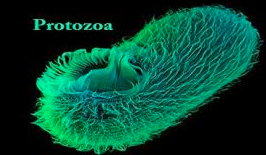PROTOZOA Multiple Choice Questions :-
1. Holozoic nutrition is characterized by
A. phagocytosis of solid nutrients and subsequent formation of phagocytic vacuoles
B. pinocytosis of solid nutrients and subsequent formation of phagocytic vacuoles
C. phagocytosis of soluble nutrients and subsequent formation of phagocytic vacuoles
D. photosynthesis
Answer: A
2. Organisms with amoeboid cells that move within a network of mucous tracks using a typical gliding motion belong to which phylum of Protozoa?
A. Labyinthomorpha B. Microspora
C. Apicomplexa D. Myxozoa
Answer: A
3. Saprozoic nutrition is characterized by
A. phagocytosis of solid nutrients and subsequent formation of phagocytic vacuoles
B. pinocytosis of solid nutrients and subsequent formation of phagocytic vacuoles
C. encystment of solid nutrients and subsequent formation of secretory vacuoles
D. pinocytosis of soluble nutrients and subsequent formation of phagocytic vacuoles
Answer: D
4. Which of the following is least likely to have a rigid cell wall?
A. Bacterium
B. Archaean
C. Fungus
D. Protozoan
Answer: D
5. The numbers of nuclear divisions involved in a ciliate undergoing binary fission is
A. greater than conjugation
B. lesser than conjugation
C. equal to conjugation
D. none of these
Answer: B
6. Which of the following is not a function of cysts for Protozoa?
A. Protect against adverse environments
B. Sites for nuclear reorganization and cell division
C. Serve as a means of transfer between hosts in parasitic species
D. All of the above
Answer: D
7. Which of the following is not true of protozoa?
A. Lack cell wall
B. Produce no sporebearing structures
C. Comprise the microbial population known as phytoplankton
D. Form active feeding forms called trophozoites
Answer: C
9. Organisms with complex life cycles which include a mammalian host and an insect host and involves schizogony as part of the cycle belong to which phylum of Protozoa?
A. Sarcomastigophora
B. Microspora
C. Apicomplexa
D. Myxozoa
Answer: C
10. A protozoan is defined as
A. motile prokaryotic unicellular protist
B. motile eukaryotic unicellular protist
C. motile eukaryotic unicellular photosynthetic protist
D. motile eukaryotic multicellular protist
Answer: C

PROTOZOA Objective type Questions with Answers
11. Organisms which have spore-forming stage in their life cycle and lack special locomotory organelles belong to which phylum of Protozoa?
A. Microspora
B. Myxozoa
C. Ciliophora
D. Apicomplexa
Answer: D
12. Members of the Protozoa may motile by all of the following methods except
A. flagella
B. gliding by slime secretion
C. cilia
D. pseudopodia
Answer: B
14. Which of the following describes the function of a phagocytic vacuole?
A. Contain specific enzymes that perform various functions
B. Maintain osmotic balance by continuous water expulsion
D. Sites of food digestion
Answer: D
16. Organisms are parasitic and have a resistant spore with one to six coiled polar filaments belong to which phylum of Protozoa?
A. Labyinthomorpha
B. Sarcomastigophora
C. Apicomplexa
D. Myxozoa
Answer: D
17. Which of the following is least likely to get in or on a protozoan such as a diplomonad or trichomonad?
A. Flagella
B. More than one nucleus
C. Genes to produce a cyst form
D. Rigid polysaccharide cell wall
Answer: D
18. Members of which phylum of Protozoa are being considered as biological control agents for certain insects?
A. Microspora
B. Sarcomastigophora
C. Apicomplexa
D. all of these
Answer: A
19. Protozoa are generally not
A. multicellular
B. microscopic
C. lacking cell walls
D. eukaryotic
Answer: A
20. Number of motility structures on flagellated cells is
A. greater than ciliated cells
B. lesser than ciliated cells
C. equal to ciliated cells
D. none of these
Answer: B
21. Protozoa have several types of vacuoles.The function of a contractile vacuole is to
A. maintain osmotic balance by continuous water expulsion
B. creates sites of food digestion
C. contain specific enzymes that perform various functions
D. have sites for photosynthesis
Answer: A